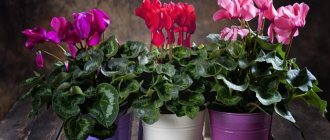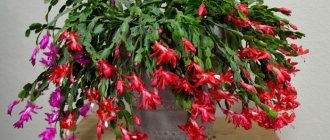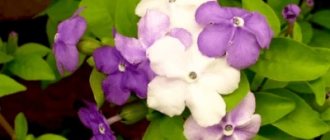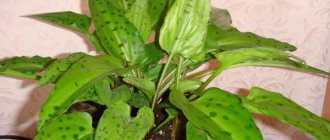Persian cyclamen will not leave any plant lover indifferent, attracting attention with its beautiful flowering and cute heart-shaped leaves. The compact plant becomes a decoration and a bright accent in many homes.
Cyclamen or alpine violet grows in nature in the clearings and forest edges of Asia Minor, Iran, and Europe. Two species are grown indoors - European and Persian , the differences of which are significant.
The cyclamen flower has an interesting shape of petals turned up. They bloom in lush color on long peduncles above the leaves, showing all their beauty for up to 3 months.
The most common colors are pink, red, and white. The size of the plant depends on the variety; even miniature varieties have been bred, for example, Mini Aneli with a peduncle height of 15 cm.
The appearance of the plant and its appearance with photos
Cyclamen persica, known to gardeners as alpine violet, is a perennial tuberous-rooted herbaceous plant from the genus Cyclamen of the Marsinaceae family (according to some botanical classifications - Primroses).
Below you will see a photo of Persian cyclamen:
Origin
The homeland of the plant is called the Eastern Mediterranean, but its distribution area is much wider and includes North-East Africa, the Middle East, Spain, and Ukraine.
In Russia, wild varieties of Persian cyclamen can be found on the Caspian and Black Sea coasts, in Crimea, and the Krasnodar Territory.
Historical reference
The Romans were the first to grow Persian cyclamen in their homes and gardens, to whom it owes its spread as a houseplant throughout Europe. Since then, many of its varieties and hybrids have been developed, in a wide variety of shapes and sizes, which are successfully used in office interiors, winter gardens, and apartments.
When transplanting and caring for cyclamen, you should be careful - its tubers, flowers and peduncles are poisonous. The tubers should be stored out of the reach of children and pets .
Botanical description
Persian cyclamen reaches a height of 30 cm, although miniature (up to 15 cm) and medium-sized (up to 20 cm) varieties and hybrids are known.
The tubers are rounded and flattened (4-15 cm in diameter) with a single growing point. The basal, heart-shaped leaves, collected in a rosette, up to 14 cm in diameter, with a leathery surface, are attached to the fleshy stem with elongated reddish, brown-green petioles. Silvery veins that form an exquisite pattern give the dark or bright green leaves a special decorative effect.
Bisexual flowers are radial, with five pointed, in some varieties fringed, large (up to 5 cm) petals, blooming on long (15-20 cm) peduncles. The lower petal bends back, giving the flower a butterfly-like appearance. The colors are varied - all shades of white, pink, lilac, red, burgundy, violet, purple, lilac. During the flowering period, up to 100 flowers can bloom on one plant .
Flowering occurs in the autumn-winter period and, depending on the variety and growing conditions, lasts from 10 days to several months. Persian cyclamen is classified as an ephemeroid plant that sheds its leaves and goes into hibernation after flowering.
With proper care, the plant can live at home for 20-25 years.
Secrets of cultivation
Cyclamen does not belong to the category of capricious plants. Experts recommend strictly following the rules of care so that the flower becomes long-lived. Reproduction occurs by seed. The sowing process is not particularly difficult and looks like this:
- Seeds can be sown at any time of the year, however, the optimal period is considered to be from February to March. Where to buy seeds? In a specialized retail outlet or nurseries. You can order goods in an online store, having first checked the supplier for integrity. Which manufacturer is better to choose depends on personal preferences.
- Before starting sowing, it is necessary to soak the planting material in a weak solution of potassium permanganate for 12 hours.
- After removing the seeds from the solution, they are placed in special soil for cyclamen. It consists of sand, steamed earth and a “tulip” mixture.
- The earth crumbles into the container. Recesses up to 1 cm deep are made in the soil. Abundant watering is carried out. Seeds are placed in the grooves at a distance of 2–4 centimeters.
- The seed material is covered with a layer of soil, and film or glass is placed on top.
- The container is installed in a warm, bright room with a temperature of 18 - 20 degrees.
- The first shoots appear after 1 - 2 months. Some varieties can germinate in 5–7 months.
The sprouted shoots, on which two full-fledged leaves have already formed, must be placed in pots. To do this, you should take the following steps:
- take a pot with a diameter of 6 - 7 centimeters;
- a hole is made in the bottom;
- Expanded clay is laid on the bottom;
- the container is filled with a special soil mixture for cyclamen;
- seedlings are completely immersed in loose soil along with the tuber;
- the height point should be above the surface of the earth.
With proper cultivation of plants from seeds with high-quality planting, the first flowers will appear after 18 - 20 months.
Conditions of detention
Successful cultivation of Persian cyclamen depends on compliance with maintenance rules. First of all, you need to choose the right flower in the store.
- Purchase. It is better to buy cyclamen during the budding period. The more unblown flowers on the plant, the better.
A healthy flower has leaves of a rich green color, without damage, with good trugor. Peduncles are strong, elongated upward.The tubers should protrude halfway out of the ground. There should be no gray coating in the center of the flower, signaling gray rot.
Place and lighting . Persian cyclamen feels best in cool rooms on window sills oriented east or west. The light is preferably bright, but diffused. Direct sunlight can cause burns on the leaves. With a lack of light, the leaves begin to turn yellow and wither.- Temperature .
For long-term flowering, cyclamen needs coolness. Daytime temperature is within + 12-16 °C, night + 10 °C. When the temperature rises above + 20 °C, the plant begins to prepare for a dormant period - it loses color, the leaves begin to turn yellow and fall off. It should also be taken into account that cyclamen does not tolerate sudden changes in temperature and drafts. During the dormant period, the plant is kept in a room with a constant temperature of + 12-25 °C. - Humidity and air quality. Persian cyclamen requires high or medium levels of air humidity. To maintain an optimal indicator, the air around the plant is regularly sprayed, trying not to get on the flowers, and the pot is placed in a tray filled with wet pebbles (expanded clay).
Cyclamen does not tolerate polluted air or tobacco smoke. It requires constant access to fresh air, so the room is often ventilated without creating a draft, and flower pots are placed at a fairly large distance from each other.To improve the process of photosynthesis, remove dust from the leaves with a soft brush.
- The soil . Suitable soil mixtures include ready-made mixtures for bulbous plants, a mixture of fertile garden soil with river sand, a mixture of leaf soil (3 parts) and 1 part each of humus, sand and peat.
- Watering. During the “awake” period - uniform, moderate, regular (every other day). The soil should not be too dry or waterlogged.
It is best to place the flower pot for 15-20 minutes in a tray filled with settled water at room temperature, or carefully water the soil along the edge of the pot, avoiding water getting on the tubers and leaf rosette.During the dormant period, watering is reduced to once a week or stopped altogether. As new leaves begin to grow, the frequency of watering is gradually increased.
- Feeding. Cyclamen is responsive to fertilizing; fertilizers are applied:
- 20 days after planting (transplant);
- during the period of growth of new leaves, with regularity once every 10-14 days;
- During budding and flowering, use complex fertilizers with a high phosphorus content once every two weeks.
Pitfalls of purchased cyclamen
Store-bought cyclamen is handled with care. Before entering the house, the plant experienced several stresses due to transplantation and a change in the usual climate. The conditions of its maintenance in the greenhouse differ from those at home. The flower needs to be helped to get used to its new life. Replanting cyclamen after purchase is recommended after 1-2 months. Vigorous peduncles and leaves may wilt after a day in the apartment. Don't rush to water or feed them.
The plant adapts to the new temperature and humidity. Choose a cool but bright place for it. Check the degree of moisture in the earthen ball with a dry stick. If necessary, water through the drip pan. Fertilizers will not be needed for several months. The fact is that store-bought specimens are overfed for abundant flowering. Spraying water with Zircon will help the leaves recover. This is a universal growth regulator that increases disease resistance and root formation activity.
When is a transplant necessary?
Often indoor flowers are sold in transport soil, not intended for long-term use. It is poor in nutrients, but is impregnated with a large amount of fertilizers. This supports the plant for a certain time, and then it begins to turn yellow and wither. Replanting from such soil is desirable before the end of the adaptation period. It is necessary to change the soil in the following situations:
- noticed pests in the ground;
- low quality substrate;
- rotting of plant roots.
Home care
How to care at home? When caring for it, you should take into account the specifics of its life cycle - the presence of a phase of active growth (flowering) and a dormant period.
During the resting phase
After the end of the active growth phase, the wilted flowers are carefully removed from the plant . You should not trim them, as this can injure the plant. The flowers are carefully twisted at the base with a sharp movement. The leaves are not torn off so as not to damage the tuber; they fall off on their own. Watering is gradually reduced to a minimum.
After one tuber remains in the pot, you can:
- Take the pot with cyclamen into the garden or onto the balcony, placing it in a dark place, watering it occasionally to prevent the earthen ball from drying out. In August-September, the plant is returned to its original place and the amount of watering is increased.
- Dig up the tuber, wrap it in thick paper and put it in the vegetable drawer in the refrigerator until autumn. At the end of summer, the “preserved” tuber is taken out and planted.
- Watering is gradually reduced until it stops completely. After the last leaf has fallen, the pot with the remaining tuber is placed on its side. In July-August, the plant is replanted and watering is resumed.
With proper care, cyclamen blooms again after 2-3 months.
Transfer
When new leaves begin to grow, it is advisable to replant the plant. The transplant algorithm is simple :
- Choose a wide pot, 2-3 cm larger in diameter than the previous one. In a container that is too large, the plant produces fewer buds, and flowering becomes less lush and long-lasting.
- A drainage layer and prepared soil mixture are poured into the pot.
- The rhizome is carefully dug up, the soil is shaken off, leaving some on the tuber. The tuber is buried 2/3 into the ground.
- After transplantation, before flowering begins, complex mineral fertilizers for flowering plants are applied twice a month.
Lighting
Cyclamen, as a native inhabitant of sunny regions, loves light . But this does not mean that you should expose the plant pots to direct sunlight: the north or east side with large windows will be the ideal solution to meet the flower’s light needs. Diffused soft light will be sufficient for normal flower development.
The best location of the plant is on eastern windows
ADVICE! If cyclamen leaves turn yellow, then one of the reasons may be prolonged exposure to the burning rays of the sun.
The rich pink color of cyclamen lifts your spirits and brings aesthetic pleasure
Reproduction
Persian cyclamen is propagated at home by seeds and vegetatively by dividing the tuber. However, both methods do not provide guaranteed results.
Most modern cyclamens are hybrids . When grown from seeds, varietal characteristics are lost, the plant becomes smaller, the activity and duration of flowering is reduced.
In addition, the seed method is labor-intensive. To begin with, the plant is artificially pollinated, then the seeds are collected, calibrated, processed, and sown for seedlings. The seedlings, in turn, are picked, fed, hardened and only then planted. A plant obtained from seeds blooms no earlier than after a year, or even two.
Dividing the tuber also does not give positive results. Very often, the tuber is affected by gray rot and the plant dies. The easiest way is to purchase seeds, tubers or a new plant in the store.
How to care immediately after purchase
After the purchase, you need to conduct an inspection of the condition of the root system, based on the results of which a decision is made on the need for replanting.
A new place for cyclamen is necessary in the following cases:
- the roots are peeking out of the hole at the bottom of the pot;
- the pot contains peat or a substrate of unknown origin, and not soil;
- when signs of rotting of the tuber are detected;
- when the tuber is completely drowned in the ground.
How to carry out a transplant is described in the corresponding section below.
Similar flowers
Persian cyclamen is similar to other representatives of its genus (African, graceful, Balearic, Cypriot, Greek, Colchian, Lebanese, ivy, amazing, Turkish, Somali). However, it is most often confused with cyclamen purpurea (European). The easiest way to distinguish these two species is by their leaves - the European species has a reddish underside of the leaf blade. European cyclamen does not shed its leaves and does not go into a dormant state .
It is very reminiscent of Persian cyclamen, another representative of the Primrose family - dodecatheon. It has very beautiful small flowers collected in inflorescences with curved petals on high peduncles. Dodecatheon, unlike Persian cyclamen, blooms in summer.
Some varieties of orchids have some similarities with cyclamen flowers. Especially phalaenopsis.
Like the Persian cyclamen, hyacinths and Uzumbara violets bloom in winter. The flowers of some hyacinths and Uzumbara violets are similar to those of cyclamen .
Many gardeners consider Persian cyclamen a capricious plant. However, caring for it is not that difficult. Hobbyists plant entire gardens of these plants on their windowsills, pleasing the eye during the long winter.
Experienced and novice gardeners appreciate cyclamen for its variety of colors, pleasant aroma and different methods of propagation. A mix of different types of these plants looks very beautiful and original. In this case, mainly miniature varieties are used. You will learn about popular varieties, as well as where and how they can be planted, on the pages of our website.
Diseases and pests
The main problems with the condition of the plant arise from improper care , but diseases from pests can also develop.
Fungal diseases
Fusarium wilt . It manifests itself as yellowing of the leaves and the appearance of brown spots on the tuber. To save the plant from death, the drug Fundazol is used.
Gray rot
Spots resembling mold appear on leaves and flowers. Destroyed by watering with a fungicidal agent.
Ticks
Quite often, cyclamen is affected by red spider mites, which manifest themselves as yellow spots on the leaves. The drug Fitoverm can help fight this pest.
If the plant is infected with cyclamen mites, the edges of the leaves will begin to curl and turn brown. This mite is dangerous due to the lack of drugs to destroy it, so the affected plant will have to be disposed of.
As it became clear, Persian cyclamen is not easy to care for, but for the efforts of the owner it will delight the owner in the cold winter with delicate flowering for many years.
White fairy tale
Long petals with a small fringe along the edge distinguish the White Fairy Tale variety. The collected buds may have a pinkish tint. The plant looks advantageous in a group, among crops with dark green foliage.
In winter, the flower can be placed on an insulated loggia. When watering, carefully ensure that water does not fall on the leaves. If the air is too dry, it is recommended to place a container of water nearby.
Lilu
A distinctive feature of the Lilu variety is fringed flowers of various shades. More famous are pink and scarlet, as well as purple cyclamens. Peduncles are quite long, powerful, erect. The leaves have a beautiful light green pattern.
Seeds for propagation are sown in early autumn. When tubers form, young plants are planted in individual containers.
What to look for when purchasing a plant?
- It is important to carefully examine the leaves and tuber (visible part) for rot. If such a precedent is found, the plant is not suitable for cultivation. A plant without signs of rotting or spoilage of leaves is an option that will be optimal not only to please with flowers for a short time, but also as a long-lived plant. After all, the lifespan of a healthy plant can reach up to twenty years.
- The best time of year to buy cyclamen is the autumn season.
- It is preferable to take a plant that is ready to flower, with the first buds just beginning to form and not yet blooming.
- The tip of the tuberous bulb must be visible.
When is immediate transplant required?
- The roots come out through the drainage holes.
- The pot is filled with peat or a similar substrate, but not soil.
- If the tuber is rotten.
- If the bulb-tuber is deeply buried, it is recessed into the soil mixture.
In the future, transplantation is done once a year, after the end of the dormant period, before the formation of buds. On average, this happens in the middle of the summer season, when new leaves begin to form. This process requires a lot of nutrition and strength, the soil is depleted and therefore replanting becomes a necessity.
Important! Blooming cyclamen or all covered with buds should not be replanted, as this may result in death.
Botanical description
Dryakva, winter gdula or alpine violet, primrose - these are all names of one plant - Cyclamen.
Herbaceous, perennial, plant from the Primrose family, subfamily – Myrsinaceae; corm. Originally from the countries of Southern, Central Europe, the Mediterranean and Asia Minor. There are over 60 species!
The leaves are colored in a dark green tone and have a round shape, reminiscent of a heart, egg or kidney. An impressive tuberous root, formed underground, turns into a strong single stem, reaching a size of 28 - 32 cm. The buds are small in size, approximately 5 - 6 cm , located on thin peduncles, which are located above the foliage. Cyclamen blooms very beautifully, and from the outside you might think that there is a flock of butterflies in the room.
The petals come in a wide variety of colors: linden, scarlet, snow-white, purple, burgundy and orange, lilac and red, two-tone with a border. But even without flowering, compared to other indoor pets, the “flower of happiness” looks impressive.
The only drawback this charming plant has is toxicity. You should not grow primrose if you have pets and children at home.
Orpheus
A spectacular bright red flower with delicate petals. The peduncle of this variety is long. The bush is compact. The plant rests throughout the summer, and in winter it produces buds.
Orpheus is propagated at the end of August by sowing in pots with garden soil and peat. Plantings should be well watered and covered with dark film. Shoots will appear in about a month.
Album
This variety of European cyclamen is cultivated as a garden plant. It blooms in spring. Its delicate white flowers bloom on peduncles up to thirty centimeters high and have a rather original structure. Their petals widen sharply at the very base. This species is characterized by very beautiful silver-marbled leaves that appear in autumn and overwinter under the snow.











